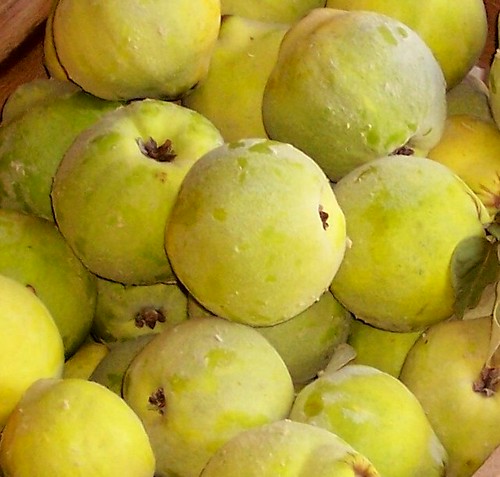
I was going to write a single post about making quince marmalade. I have instead written enough to declare this Quince Week here at The Belfry. If this is reasonable or not I don't know, but here we are. Let's talk about quinces.
Specifically, let's talk about the fruit of Cydonia oblonga, which is native to the Causcasus region, and is not to be confused with the flowering quinces, Chaenomeles species and hybrids, which are native to China, Japan, and Korea, or with the Chinese quince, Pseudocydonia sinensis. All these quinces are members of the family Rosaceae, and all produce fruit, but it is C. oblonga that is the real star of the family from a culinary perspective.
The tree and its culture are legitimately ancient -- the Akkadians, over 4000 years ago, knew it as supurgillu. It is speculated that the cultivation of quinces predated that of apples, and that the fruit called apple in biblical texts (e.g., The Song of Solomon) and in Greek myth (Atalanta, the garden of the Hesperides, the judgment of Paris) may in fact have been quince. The Greek name for the fruit was Kydonian apple (κυδώνιον μῆλον), from the city in of Kydonia in Crete, where it was grown.
The Romans seem to have acquired quinces from the Greeks, along with all the other things they took from their eastern neighbours, and spread them further westward with their empire. Quinces are described by Plutarch, Columella, and Pliny the Elder, among others; Apicius included recipes for quinces, including a patina de cydoniis of quinces and leeks cooked in honey and broth. Dioscorides, Galen, and other classical medical writers included it in their materia medica, considering it astringent (and therefore useful against excesses of choler and phlegm) as well as good for the digestion.
Later, Charlemagne listed the quince among the trees to be planted in a well-kept orchard (Capitulare de villis 70) and it appears regularly in European cookery books from the 14th century through the 19th.
Though Pliny mentioned a variety, the Mulvian, that could be eaten out of hand, most quinces need to be cooked. The fruit sacred to Aphrodite is golden, fragrant, rock-hard, tart, and mealy in its raw state. This is, I suspect, why the quince is not a wildly popular fruit in America today; it isn’t blandly sweet and suitable for tucking into a lunchbox as a ‘healthy snack.’
Up next: marmalade around the world.
John Keats

No comments:
Post a Comment